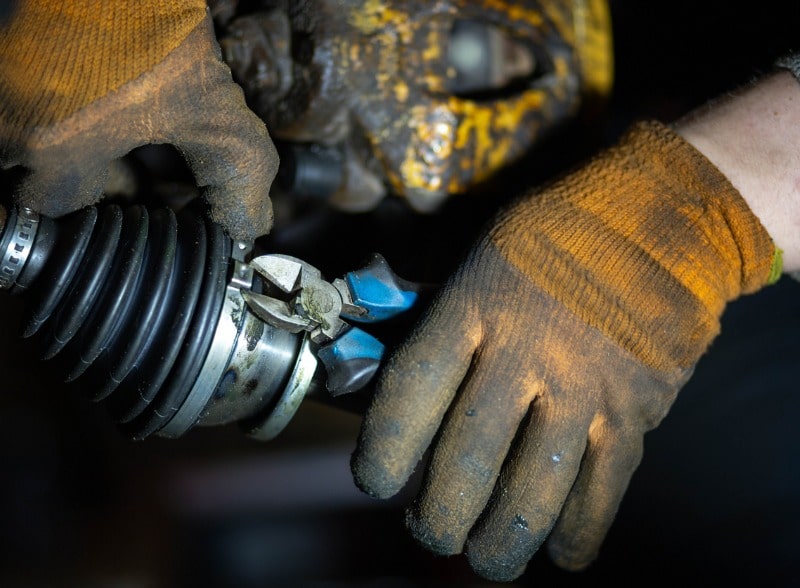How To Diagnose A Bad CV Joint & How To Tell If CV Joint Needs Replacing
Date Posted: 19 June 2023

Car anatomy is so complex, you could break it down part by part, devoting a separate blog post to each one, but today, we’re going to focus on CV joints. We’ll explain what they are and how to tell if your CV joint needs replacing. So, let’s get the wheels in motion and drive right into it—or, in the case of failing CV joints, edge forward with caution.
What Is a CV Joint on a Car?
There are a few terms for the CV joint, among which include ‘CV axle’ and ‘half shaft’. ‘CV’ stands for ‘constant velocity’, and this refers to the joint’s job of sending energy from the engine to the wheels. This constant velocity transfer results in the wheels’ constant and seamless rotation, which drivers may take for granted when hitting the accelerator. By its nature, the CV joint must also be a little bit flexible to accommodate the drive shaft, which drivers will use to shift angles as they navigate the space ahead.
Is a Drive Shaft the Same as a CV Joint?
While connected and instrumental to the same purpose, there is a fundamental difference between the drive shaft and the CV joint. While drive shafts use a universal joint to connect to other parts of the drivetrain, CV joints facilitate angle changes while maintaining consistent speeds. You could say the drive shaft prioritises the big picture while the CV joint focuses on keeping up to speed as it embraces change.
How to Tell If Your CV Joint Needs Replacing
Like any car part, the CV joint will deteriorate from natural wear and tear or reduced lubrication. Sometimes accidents happen, and your CV joint will be a casualty in the case of a damaged CV boot. Whatever the cause, you will likely need to replace your CV joint somewhere down the line. Here are some signs you’ve arrived at that point.
Knocking, Clicking and Other Peculiar Noises
If you’re hearing a peculiar noise from the front wheels such as knocking or clicking, that’s a sign something’s amiss. The culprit won’t necessarily be the CV joint, but if the noise coincides with your vehicle turning, you should consider it the leading suspect.
Vibrations
If your car’s giving you bad vibrations, that’s a cue something’s off. And because the CV joint neighbours the car’s wheels, it’s a strong suspect. Anything that affects the wheels will impact your driving and likely manifest as vibrations. Again, your CV joint isn’t necessarily to blame; however, in any case, you should get someone to check your shaky car.
Greasy Wheels
If Greased Lightnin’ is burning up before the quarter mile, you need to decrease the speed and degrease those dirty wheels. Any damage sustained to the CV boot will result in greasy leaks—all throughout those wheels of yours. This happens because the CV joint requires heavy lubrication to perform at its peak, and a compromised boot won’t hold its liquid. Greasy leaks are a car’s version of haemorrhaging—but instead of a blood vessel, it’s the CV joint that’s busted.
CV Boot Damage
If the CV boot’s busted, that’s that. Unlike the other signs, however, this fault is much easier to check for. Can you drive with a broken CV joint? Yes, but it’s not safe. Furthermore, the longer you do, the more you’re exposing the joint to external contaminants and inviting grease leakage. If it’s just the boot that’s the problem, you can replace this part as opposed to the entire joint. Otherwise, if you leave it too long, you’re in for an expensive auto repair bill.
What Happens When a CV Joint Fails?
In a worst-case scenario, your CV joint will fail and you’re looking at an immobile automobile. Of course, if this failure happens while you’re on the road, your car is a stationary hazard. Sudden stops or loss of car control are the makings of car accidents.
Before it reaches this point, a faulty CV joint can impact your car. Can bad CV joints cause tyre wear? Yes, they can—both premature and uneven. Because the CV joint neighbours the wheels, this area will take the first toll. That said, because the wheels are the foundation upon which your car stands, any issues at this base level are sure to spread from there—à la dominos—the longer you leave them.
Where to Replace Your CV Joint
If any of these signs vibrate or resonate with you, you need to replace your CV joint pronto. This is a time-sensitive issue as well as a matter of safety. Luckily, at Machter, we stock quality and affordable CV joints—among other aftermarket car parts—to get you back on the road. Or, if your CV joint is fine and you’re here as a hobbyist, we also have plenty of car parts for you to play around with. At Machter, we are auto enthusiasts who build car parts both universal and tailored to specific car models. Why not browse our store and see how we can help you?





